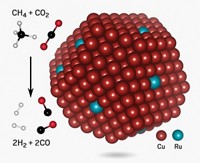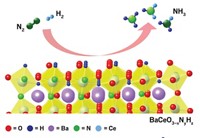Advertisement
Grab your lab coat. Let's get started
Welcome!
Welcome!
Create an account below to get 6 C&EN articles per month, receive newsletters and more - all free.
It seems this is your first time logging in online. Please enter the following information to continue.
As an ACS member you automatically get access to this site. All we need is few more details to create your reading experience.
Not you? Sign in with a different account.
Not you? Sign in with a different account.
ERROR 1
ERROR 1
ERROR 2
ERROR 2
ERROR 2
ERROR 2
ERROR 2
Password and Confirm password must match.
If you have an ACS member number, please enter it here so we can link this account to your membership. (optional)
ERROR 2
ACS values your privacy. By submitting your information, you are gaining access to C&EN and subscribing to our weekly newsletter. We use the information you provide to make your reading experience better, and we will never sell your data to third party members.
Synthesis
Solar Energy Splits Hydrogen Sulfide
Redox chemistry turns toxic waste into valuable hydrogen and sulfur
by Elizabeth K. Wilson
April 14, 2014
| A version of this story appeared in
Volume 92, Issue 15
A new process uses sunlight to split hydrogen sulfide into its components, hydrogen and sulfur (Angew. Chem. Int. Ed. 2014, DOI: 10.1002/anie.201400571). Ubiquitous and toxic, H2S is produced during industrial reactions and in the environment. Currently, industry uses the Claus process to partially oxidize H2S to elemental sulfur and water. But a much more attractive prospect would be to generate H2 and S, turning waste into valuable commodities. Chemists in search of effective, efficient reactions to split H2S have tried thermal, thermochemical, and electrochemical approaches, with varying degrees of success. A reaction using solar energy would be preferred, however. In a proof-of-concept experiment, an international team led by Can Li of China’s Dalian Institute of Chemical Physics and Lianzhou Wang of the University of Queensland, Australia, converted H2S to sulfur and protons using redox couples (I−/I3− or Fe2+/Fe3+). Then, a photoelectrode made of functionalized silicon reduced the protons to form H2. Challenges still remain to make the process industrially useful, including separating the elemental sulfur from water and purifying it.




Join the conversation
Contact the reporter
Submit a Letter to the Editor for publication
Engage with us on Twitter